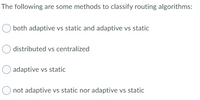
Computer Networking: A Top-Down Approach (7th Edition)
7th Edition
ISBN: 9780133594140
Author: James Kurose, Keith Ross
Publisher: PEARSON
expand_more
expand_more
format_list_bulleted
Question

Transcribed Image Text:The following are some methods to classify routing algorithms:
both adaptive vs static and adaptive vs static
distributed vs centralized
adaptive vs static
not adaptive vs static nor adaptive vs static
Expert Solution
This question has been solved!
Explore an expertly crafted, step-by-step solution for a thorough understanding of key concepts.
Step by stepSolved in 2 steps

Knowledge Booster
Similar questions
- Consider the network shown below. Show the operation of Distance vector routing algorithm for computing the least cost path from F (the rightmost node in the figure below) to all destinations. Also explicitly list all the shortest path routes from F to all destinations that are the result of the algorithm's computation. Depict all the steps through diagram. B) 1 4. 3. E) F A 3 D 4.arrow_forwardSavod 30 Required information NŐTE: This is a multi-part question. Once an answer is submitted, you will be unable to return to this part Find the shortest route (in distance) between computer centers in each of the pairs of cities in the communications network shown in the following image: Ot:02:06 Boston 860 Chicago 191 San Francisco 1855 722 New York 908 Denver 1736 257 349 1372 Los Angeles 1235 Dallas Dallas and San Francisco Multiple Choice Dallas to Denver to San Francisco Dallas to Chicago to Denver to San Francisco Dallas to Chicago to San Francisco Dallas to Los Angeles to San Franciscoarrow_forwardC PROGRAMMING you are to write a TCP/IP server that can build up a graph of a network ofnetworks (using the supplied graph library and implementation of Dijkstra’s algorithm) and thenquery that graph to find out which link between two networks should be used as the next hop tosend a packet of data from one network to another within the network of networks (using thesupplied implementation of Dijkstra’s algorithm). using the following program as a start point: /* * NetworkServer.c * ProgrammingPortfolio Skeleton * */ /* You will need to include these header files to be able to implement the TCP/IP functions */#include <stdio.h>#include <stdlib.h>#include <string.h>#include <sys/types.h>#include <netinet/in.h>#include <netdb.h>#include <fcntl.h>#include <unistd.h>#include <errno.h>#include <sys/socket.h> /* You will also need to add #include for your graph library header files */ int main(int argc, const char * argv[]){ int…arrow_forward
- Prim's MST approach has the potential to be used to a weighted real-world network as it is now being built.arrow_forward3. Consider the M/M/1 queue discussed in class. Assume that packets arrive to a queue with average arrival rate A [pkts/s]. The average service rate of the queue is denoted by u [pkts/s]. (a) Write expressions for: (i) the mean time between packet arrivals to the queue, i.e., the average inter-arrival time; and (ii) the mean service time, i.e., the average time needed to transmit a packet onto the outgoing link. (b) Let N denote the number of packets in the system in steady-state. Suppose A = 850 and u 1000. Find the smallest value of B such that P(N > B) < e = 10¬4. Hint: Use MATLAB or some other computational tool (you could even use an Excel spreadsheet) to test different values of B. 4. Consider the M/M/1 queue from Problem 3. (a) Find an expression for E[N], i.e., the average number of packets in the system in steady- state. For the values of A and µ specified in Problem 4(b), compute the value of E[N]. What happens when A→ µ? (b) Find an expression for Var[N], i.e., the variance…arrow_forwardIn a distributed system, multiple copies of software are present on each node. What is its true significance?arrow_forward
arrow_back_ios
arrow_forward_ios
Recommended textbooks for you
 Computer Networking: A Top-Down Approach (7th Edi...Computer EngineeringISBN:9780133594140Author:James Kurose, Keith RossPublisher:PEARSON
Computer Networking: A Top-Down Approach (7th Edi...Computer EngineeringISBN:9780133594140Author:James Kurose, Keith RossPublisher:PEARSON Computer Organization and Design MIPS Edition, Fi...Computer EngineeringISBN:9780124077263Author:David A. Patterson, John L. HennessyPublisher:Elsevier Science
Computer Organization and Design MIPS Edition, Fi...Computer EngineeringISBN:9780124077263Author:David A. Patterson, John L. HennessyPublisher:Elsevier Science Network+ Guide to Networks (MindTap Course List)Computer EngineeringISBN:9781337569330Author:Jill West, Tamara Dean, Jean AndrewsPublisher:Cengage Learning
Network+ Guide to Networks (MindTap Course List)Computer EngineeringISBN:9781337569330Author:Jill West, Tamara Dean, Jean AndrewsPublisher:Cengage Learning Concepts of Database ManagementComputer EngineeringISBN:9781337093422Author:Joy L. Starks, Philip J. Pratt, Mary Z. LastPublisher:Cengage Learning
Concepts of Database ManagementComputer EngineeringISBN:9781337093422Author:Joy L. Starks, Philip J. Pratt, Mary Z. LastPublisher:Cengage Learning Prelude to ProgrammingComputer EngineeringISBN:9780133750423Author:VENIT, StewartPublisher:Pearson Education
Prelude to ProgrammingComputer EngineeringISBN:9780133750423Author:VENIT, StewartPublisher:Pearson Education Sc Business Data Communications and Networking, T...Computer EngineeringISBN:9781119368830Author:FITZGERALDPublisher:WILEY
Sc Business Data Communications and Networking, T...Computer EngineeringISBN:9781119368830Author:FITZGERALDPublisher:WILEY

Computer Networking: A Top-Down Approach (7th Edi...
Computer Engineering
ISBN:9780133594140
Author:James Kurose, Keith Ross
Publisher:PEARSON

Computer Organization and Design MIPS Edition, Fi...
Computer Engineering
ISBN:9780124077263
Author:David A. Patterson, John L. Hennessy
Publisher:Elsevier Science

Network+ Guide to Networks (MindTap Course List)
Computer Engineering
ISBN:9781337569330
Author:Jill West, Tamara Dean, Jean Andrews
Publisher:Cengage Learning

Concepts of Database Management
Computer Engineering
ISBN:9781337093422
Author:Joy L. Starks, Philip J. Pratt, Mary Z. Last
Publisher:Cengage Learning

Prelude to Programming
Computer Engineering
ISBN:9780133750423
Author:VENIT, Stewart
Publisher:Pearson Education

Sc Business Data Communications and Networking, T...
Computer Engineering
ISBN:9781119368830
Author:FITZGERALD
Publisher:WILEY